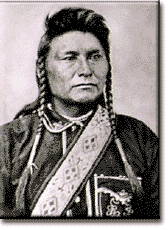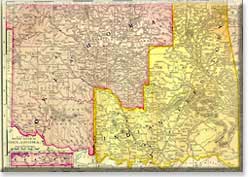40c. The End of Resistance

"I have heard talk and talk, but nothing is done. Good words do not last long unless they amount to something. Words do not pay for my dead people. They do not pay for my country, now overrun by white men. Good words will not give my people good health and stop them from dying. Good words will not get my people a home where they can live in peace and take care of themselves. I am TIRED of talk that comes to nothing."
The crackdown on Native Americans did not end with the pursuance of Custer's attackers. Any tribes resisting American advancement were relentlessly hunted by settlers and federal troops. The Lakota Sioux that fought for their lands were decimated by yet another American tactic.
Decimation of the Buffalo
Travelers west were encouraged to kill any buffalo they encountered. Buffalo robes became fashionable in the East, so profit-seekers slaughtered thousands of bison simply for their hides. Others shot them for sport, leaving their remains for the local vultures.
The army was even known to use Gatling guns on the herds to reduce their numbers. The plan was effective. At the end of the Civil War, an estimated 15 million buffalo roamed the Great Plains. By 1900, there were only several hundred, as the species was nearly extinct. The Sioux lost their chief means of subsistence and mourned the loss of the animal, which was revered as sacred according to tribal religion.
Chief Joseph and the Nez Percé
The year after Custer's infamous defeat, the Nez Percé Indians of Idaho fell victim to western expansion. When gold was discovered on their lands in 1877, demands were made for over 90 percent of their land. After a stand-off between tribal warriors and the United States Army, their leader Chief Joseph directed his followers toward Canada to avoid capture. He hoped to join forces with Sitting Bull and plan the next move from there.
Army officials chased the Nez Percé 1700 miles across Idaho and Western Montana. As they neared the border, the army closed in and Chief Joseph was forced to surrender. The entire tribe was relocated to Oklahoma where nearly half of them perished from disease and despair.
Geronimo and the Apache Struggle
Warfare also raged across the American Southwest. The Apache tribe led one of the longest and fiercest campaigns of all. Under the leadership of Geronimo, Apache attackers assaulted settlers in Texas, Arizona, and New Mexico. The army responded slowly but surely. Geronimo was relentlessly hunted, even across the Mexican border.
Finally, after the army seized female Apaches and deported them to Florida and deprived the warring tribesmen of a food supply, Geronimo was captured. His 1886 defeat marked the end of open resistance by Native Americans in the West.
Sooners Grab Oklahoma

This 1895 map shows many of the Native American tribes which suffered forced relocation to Oklahoma Territory. Among the tribes were the Cherokee, Miami, and Quapaw.
The last land to be claimed by homesteaders was in Oklahoma. Previously dubbed "Indian Territory" by the federal government, Oklahoma had been used as a state-sized reservation of many tribes ranging from the Nez Percé in Idaho to the Cherokee of Georgia.
In 1889, the United States Government decided to open two million acres of land unassigned to any particular tribe for homesteaders. At noon on April 22, 1889, the land was legally opened to claim under the provisions of the Homestead Act. Thousands rushed across Oklahoma to grab a piece. Highlighted by a few gunshots, former Indian land was gobbled up in a matter of hours.
By nightfall, Oklahoma City qualified as a city of 10,000 tent inhabitants. Those who dared to stake a claim before it was legal were called Sooners, and the state acquired its future nickname. Successful homesteaders rested that night in triumph, leaving the Indians of the area to despair over yet another grand theft.






